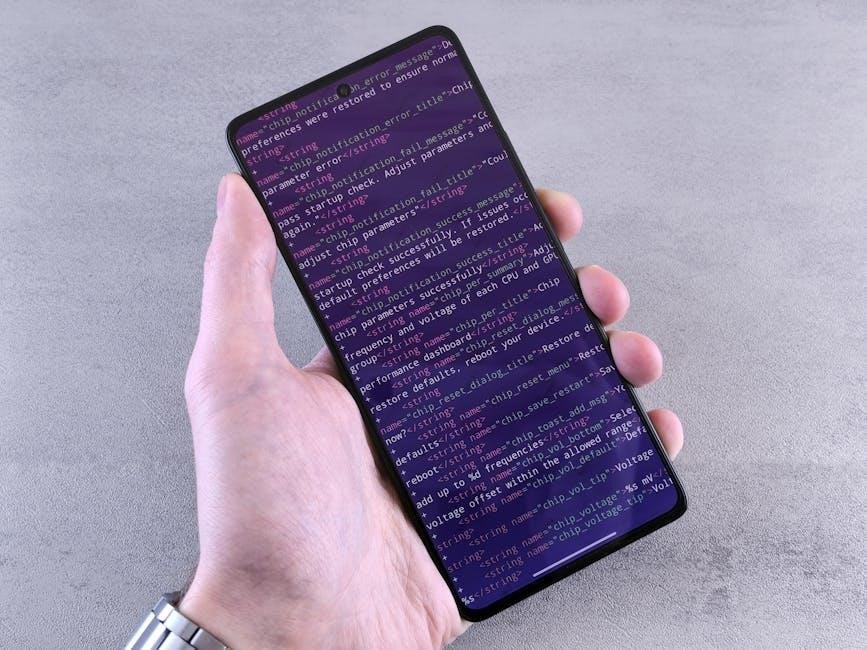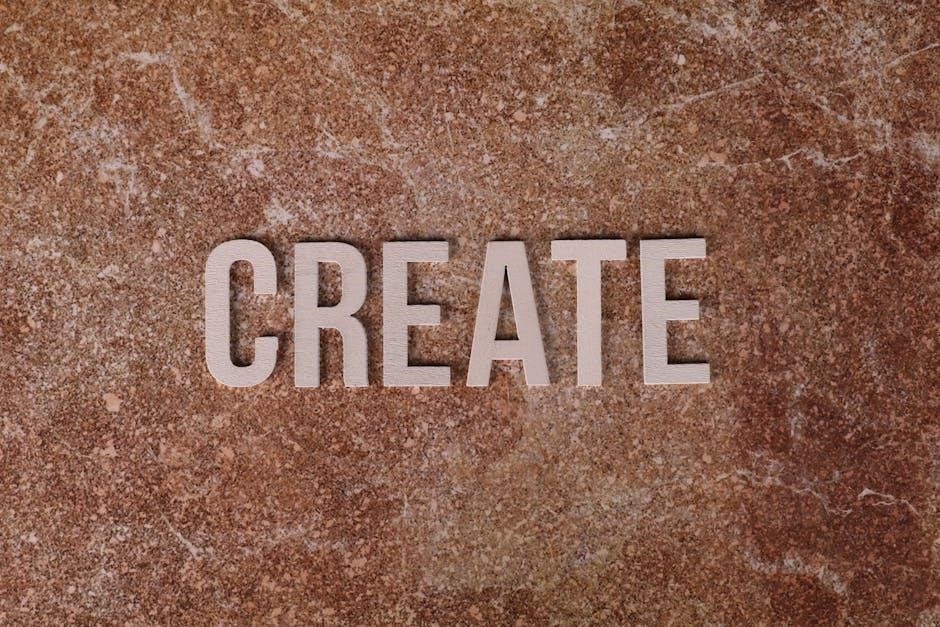
dungeon masters screen pdf
The Dungeon Master (DM) screen is a versatile tool for organizing game mechanics, notes, and rules, serving as both a shield and reference guide during sessions. It streamlines gameplay by providing quick access to essential charts, conditions, and monster stats, ensuring smooth storytelling and efficient rule checks. A well-prepared DM screen enhances immersion and keeps the game flowing seamlessly.
1.1 Overview of the Dungeon Master Screen
The Dungeon Master (DM) screen is a essential tool designed to enhance gameplay efficiency and organization. It typically includes quick-reference charts for combat mechanics, skill checks, and monster stats, allowing DMs to manage complex rules seamlessly. Customizable inserts and cheat sheets enable DMs to tailor the screen to their campaign needs, ensuring key information is always accessible. The screen also serves as a visual barrier, protecting the DM’s notes and plans from player view. By organizing vital resources like conditions, initiative trackers, and NPC data, the DM screen streamlines storytelling and keeps sessions engaging. Its versatility makes it indispensable for both new and experienced DMs.
1.2 Importance of the DM Screen in D&D Games
The DM screen is a cornerstone of Dungeons & Dragons, offering a structured way to manage game mechanics and narrative elements. It acts as a central hub for quick access to critical rules, charts, and campaign-specific notes, ensuring smooth gameplay. By maintaining player engagement and immersion, the screen helps DMs weave compelling stories while keeping essential information at their fingertips. Its importance lies in its ability to enhance preparation, organization, and creativity, making it an indispensable tool for both novice and seasoned DMs. The screen’s versatility allows it to adapt to any campaign, ensuring every session is both efficient and enjoyable.

Essential Resources for the DM Screen
Official rule charts, campaign-specific notes, and third-party inserts are vital for an optimized DM screen. PDF resources and customizable layouts ensure efficiency and personalization for every game session.
2.1 Official Materials for the DM Screen
Official materials like the D&D Essentials Kit and Monster Stat Blocks provide essential charts and tables for managing combat, skills, and spells. The official Dungeon Master Screen PDF includes quick-reference guides for monsters, NPCs, and treasure. These resources are designed to streamline gameplay and reduce preparation time. They often feature comprehensive lists of rules, conditions, and effects, ensuring the DM has everything needed at a glance. Official materials are updated regularly and align with the latest edition of the game, making them a reliable foundation for any DM screen setup.
2.2 Third-Party Resources and Inserts
Third-party resources for the DM screen offer customization and convenience. Many creators design inserts and PDFs that fit specific needs, such as monster stat blocks or spell references. Websites like DriveThruRPG and Etsy host a variety of these tools. Inserts can be printed or digitally added to screens, enhancing organization. Custom art and layouts are popular, allowing DMs to personalize their screens. These resources often fill gaps in official materials, providing additional tables or quick-reference guides. They are ideal for DMs seeking tailored solutions to improve gameplay efficiency and visual appeal. Third-party options are a great way to enhance your DM screen setup beyond official content.

Organization of Information
Organizing your DM screen involves categorizing rules, stats, and notes into clear sections or tabs for quick access during gameplay, ensuring efficiency and reducing distractions.
3.1 Categories of Information to Include
When creating a DM screen, it’s essential to include categories like core rules, combat mechanics, skill checks, and monster stats. These sections ensure quick access to critical information during gameplay. Additionally, categories for NPC interactions, treasure tables, and environment-specific rules can enhance organization. Including a campaign overview and player handouts helps maintain consistency. Organizing these categories logically ensures that the DM can focus on storytelling rather than searching for rules. Customizing the categories to fit your campaign’s needs makes the screen even more effective, providing a tailored tool for seamless session management.
3.2 Tips for Customizing Your DM Screen
Customizing your DM screen enhances gameplay efficiency and personalization. Start by tailoring sections to your campaign’s theme, such as adding campaign-specific artwork or thematic inserts. Incorporate player preferences, like quick-reference tables for common skill checks or combat rules. Use tabs or color-coding to organize information for easy navigation. Include a section for house rules or custom mechanics to maintain consistency. Add personal notes or reminders to keep track of important details. Finally, experiment with digital tools or printable inserts to create a unique layout that suits your style. These tweaks ensure your screen is both functional and visually appealing, elevating your DM experience.

Cheat Sheets for Common Rules
Cheat sheets simplify gameplay by compiling essential rules, such as combat mechanics, skill checks, and spellcasting guidelines, into easy-to-reference sections, ensuring quick access during sessions.
4.1 Combat Mechanics and Initiative
A DM screen PDF often includes quick-reference charts for combat mechanics, such as initiative order, attack rolls, and damage calculations. These sections streamline battles by providing at-a-glance rules for conditions like prone, blinded, or paralyzed states. Initiative trackers and action economy reminders help maintain order during chaotic fights. Many screens also feature summaries of combat modifiers, cover rules, and opportunity attacks. This ensures that even complex encounters can be managed efficiently, allowing the DM to focus on storytelling and player engagement rather than rulebook lookups. These resources are invaluable for both new and experienced Dungeon Masters aiming to keep combat dynamic and fun.
4.2 Skill Checks and Ability Scores
A DM screen PDF often includes tables and charts for skill checks and ability scores, providing quick access to proficiency bonuses, skill DCs, and ability score modifiers. These resources help streamline skill challenges by offering at-a-glance references for skills like Acrobatics, Stealth, and Persuasion. Many screens also feature summaries of ability score effects, such as Strength-based melee attacks or Intelligence-based spellcasting. This ensures consistency in rulings and reduces downtime during sessions. Additionally, some screens include common skill challenge DCs for various tasks, making it easier for DMs to adjudicate scenes on the fly. These tools are essential for maintaining smooth and engaging gameplay.
Monster and NPC Management
Monster and NPC management sections in DM screen PDFs provide quick access to stat summaries, ability overviews, and common archetypes for easy reference during gameplay.
5.1 Tracking Monster Stats and Abilities
Tracking monster stats and abilities is crucial for smooth gameplay. A DM screen PDF should include concise summaries of key monster attributes, such as HP, AC, attack bonuses, and special abilities. Organizing this information by monster type or challenge rating helps quickly reference during encounters. Official resources often categorize monsters alphabetically or by environment, while third-party tools may offer customizable tables. Highlighting abilities like breath weapons or legendary actions ensures they are not overlooked. Including condition immunities and resistances saves time during combat. This section should also provide space for notes or adjustments for homebrew monsters, making it adaptable to any campaign setting.
5.2 Creating Quick Reference Guides
Creating quick reference guides enhances efficiency during gameplay. A DM screen PDF should include tables or charts for core mechanics, such as skill check DCs, saving throw targets, and attack bonus progressions. Combat modifiers, condition effects, and concentration rules are also essential. These guides should be visually organized, using bullet points and tables for clarity. Including a section for common spells and their effects can streamline spellcasting resolution. Cross-referencing monster stats with these guides ensures seamless transitions during encounters. Customizing these guides to fit your campaign’s unique rules or house rules further enhances their utility. This section should be concise yet comprehensive, saving time during critical moments.

Customization and Personalization
Personalize your DM screen with campaign-specific notes, artwork, and tailored rules. Add custom charts, house rules, and thematic visuals to reflect your unique storytelling style and world-building efforts.
6.1 Adding Personal Notes and Campaign-Specific Info
Enhance your DM screen by incorporating personal notes and campaign-specific details. This ensures quick access to vital information tailored to your unique game world. Include reminders for house rules, NPC personalities, and recurring themes. Add notes on player backgrounds or ongoing plot threads to maintain continuity. Organize these details into clear sections, such as a campaign timeline or a list of key locations. This personalization helps you stay immersed in your story and provides a seamless experience for your players. By integrating these elements, your DM screen becomes a dynamic tool that reflects the evolving narrative of your campaign.
6.2 Using Art and Imagery to Enhance the Screen
Elevate your DM screen with visually striking art and imagery to create an immersive experience. High-quality visuals, such as fantasy landscapes or iconic creatures, can set the tone for your campaign. Incorporate character art or maps to help players visualize the game world. Use official D&D artwork or third-party resources to enhance the aesthetic. Digital tools allow you to customize and print these images, ensuring they fit seamlessly into your screen. This not only makes your setup more engaging but also adds a professional touch, making your DM screen a focal point of the game. Art enhances storytelling and player immersion, enriching the overall D&D experience.

Digital Tools and PDF Resources
Digital tools and PDFs enhance your DM screen experience. Platforms like D&D Beyond and Roll20 offer customizable PDFs for rules, maps, and character sheets. Printable resources from DriveThruRPG or official D&D websites provide pre-designed screens. Digital PDFs allow easy organization and quick access during games. They are ideal for creating personalized layouts tailored to your campaign needs, ensuring all essential information is at your fingertips. These resources streamline preparation and gameplay, making your DM screen more efficient and visually appealing.
7.1 Best PDFs for DM Screens Available Online
Discover the best PDFs for DM screens online, offering comprehensive tools to enhance your Dungeons & Dragons games. Official sources like the D&D website and third-party platforms provide high-quality, printable screens. Popular options include the D&D Essentials Kit and Acquisitions Incorporated DM screens, featuring rules, charts, and artwork. Websites like DriveThruRPG and Etsy offer customizable PDFs tailored to specific campaigns or playstyles. Many PDFs include modular designs, allowing you to mix-and-match sections for a personalized setup. These resources are perfect for new and experienced DMs, ensuring quick access to critical information during sessions. They save time and elevate your game mastering experience.
7.2 Digital Tools for Managing Your DM Screen
Digital tools revolutionize how Dungeon Masters manage their screens, offering flexibility and convenience. Platforms like Roll20 and Fantasy Grounds provide virtual tabletop solutions, allowing DMs to organize and access rules, maps, and notes seamlessly. PDF annotation tools such as Adobe Acrobat or Xodo enable customization of DM screen layouts. Apps like D&D Beyond and The DMs Guild offer searchable databases for quick rule references. Additionally, virtual DM screens with drag-and-drop functionality can be found on platforms like Steam or Itch.io, catering to both offline and online play. These tools streamline preparation and gameplay, ensuring a smooth and immersive experience for players and DMs alike.

Player Interaction and Communication
Dynamic maps and virtual whiteboards enhance player engagement, while chat functions and voice channels in VTTs streamline communication. These tools foster immersive storytelling and organized gameplay.
8.1 Tools for Keeping Players Engaged
Engaging players requires a mix of creativity and organization. Initiative trackers, combat mats, and digital tools like virtual tabletops (VTTs) keep gameplay dynamic. A DM screen with built-in grids for mapping encounters ensures clarity. Music and sound effects can enhance immersion, while visual aids like monster tokens or character art captivate attention. Incorporating puzzles, riddles, and dynamic storytelling elements fosters active participation. Additionally, using online platforms for shared resources and notes helps maintain player interest. These tools collectively create an interactive and immersive experience, ensuring players remain invested in the adventure. A well-prepared DM screen is key to seamless engagement and fun.
8.2 Managing Player Expectations and Feedback
Managing player expectations and feedback is crucial for a balanced and enjoyable campaign. A DM screen can include sections for notes on player preferences and boundaries, ensuring clarity from the start. Session zero is a valuable tool to align expectations and discuss house rules. Regular check-ins and feedback surveys help gauge player satisfaction and identify areas for improvement. Incorporating player suggestions into the game fosters a collaborative environment, making everyone feel heard. A well-organized DM screen allows for quick reference to these details, ensuring smooth communication and a positive gaming experience for all. Open dialogue and adaptability are key to maintaining player satisfaction and engagement.

Scenario Planning and Preparation
Efficient scenario planning involves organizing encounters, NPCs, and story beats. A DM screen helps keep these elements structured and easily accessible, ensuring smooth storytelling and immersion.
9.1 Creating Maps and Encounters
Creating detailed maps and encounters is essential for immersive storytelling. A DM screen can include grid paper for sketching battlemaps or note sections for encounter ideas. Organize NPC stats, treasure, and environmental effects in one place. Use the screen to track initiative, monster abilities, and player positions. Pre-plan encounters with tables or random generators for dynamic sessions. Include visual aids like mini-maps or terrain art to inspire creativity. Ensure your screen reflects the campaign’s tone, whether it’s a high-fantasy realm or a dark dungeon. This preparation enhances gameplay and keeps players engaged in the world you’ve crafted.
9.2 Using Clues and Puzzles Effectively
Clues and puzzles add depth and engagement to your campaigns. A DM screen can include sections for tracking clues, such as riddles, hidden objects, or NPC dialogue hints. Organize puzzles by difficulty and relevance to the story. Use visual aids like charts or flowcharts to map out mystery elements. Incorporate props or handouts directly into the screen for easy access. Ensure clues are clear but not overly simplistic, and vary puzzle types to cater to different player strengths. Keep the narrative flowing by having solutions pre-planned but flexible. This approach enhances immersion and challenges players creatively, making your game unforgettable.

Tips for New Dungeon Masters
- Customize your DM screen to fit your style and campaign needs for better organization.
- Stay flexible and adapt the screen as you gain experience and confidence.
- Start simple and gradually add more complex elements as you become comfortable.
- Use the screen as a tool to enhance storytelling and player immersion.
10.1 Essential Information for First-Time DMs
For first-time DMs, the dungeon master screen PDF is an invaluable resource to streamline gameplay and maintain organization. Start by familiarizing yourself with the layout, prioritizing core rules like combat mechanics and skill checks. Use tabs or sections to quickly locate information during sessions. Keep the screen simple at first, focusing on essential tables and references. As you gain confidence, you can customize it further. Remember, the screen is a tool to enhance your storytelling, not a barrier. Stay adaptable and be ready to adjust your approach as you learn what works best for your group. The goal is to create an engaging experience for everyone, including yourself!
10.2 Common Mistakes to Avoid
When using a dungeon master screen PDF, avoid overloading it with unnecessary information, as this can lead to confusion during gameplay. Many new DMs make the mistake of including too many rules or tables, which can slow down decision-making. Another common error is failing to organize the content logically, making it difficult to find what you need quickly. Additionally, don’t rely solely on the screen; remember to engage with your players and adapt to their actions. Neglecting to update the screen with campaign-specific details can also hinder immersion. Finally, avoid using the screen as a crutch—trust your preparation and improvise when needed. Keep it simple, practical, and tailored to your game.

Advanced DM Screen Strategies
Advanced DM screen strategies involve utilizing dynamic content, integrating homebrew material, and enhancing storytelling elements. These techniques elevate gameplay and create unique, immersive campaigns.
11.1 Enhancing Storytelling with Your Screen
Enhancing storytelling with your DM screen involves creating a visually and narratively engaging tool that complements your campaign’s theme. Incorporate campaign-specific artwork, thematic colors, and key narrative elements to set the tone. Use inserts or printables that highlight important locations, NPCs, or plot devices, making them easily accessible during sessions. Adding quick-reference guides for common story beats or climactic moments ensures smooth pacing. Customizable sections for notes allow you to adapt to player choices, fostering dynamic and immersive storytelling. By integrating these elements, your DM screen becomes a powerful narrative aid, enhancing the overall player experience and keeping the story flowing seamlessly.
11.2 Integrating Homebrew Content
Integrating homebrew content into your DM screen enhances customization and tailors the game to your unique campaign. Create dedicated sections for custom rules, spells, or items, ensuring they are easily accessible during play. Use removable inserts or digital tools to swap out content as needed. Organize homebrew materials by category, such as combat, exploration, or social interactions, to maintain clarity. Including player-created content fosters collaboration and immersion, making the game feel more personal. Regularly update your screen with new homebrew elements to keep the campaign fresh and dynamic. This approach allows you to seamlessly blend official and custom content, creating a cohesive and engaging experience.
The DM screen is a cornerstone of D&D, evolving from a simple tool into an extension of the DM’s creativity and storytelling prowess. Personalization and continuous improvement ensure it remains a vital asset, enhancing both preparation and gameplay. As you refine your screen, remember its role in fostering unforgettable adventures and endless possibilities.
12.1 Final Thoughts on the DM Screen
The DM screen is a cornerstone of Dungeons & Dragons, serving as both a practical tool and a creative canvas for storytelling. Its evolution from a simple reference aid to a customizable, visually stunning accessory underscores its importance. By personalizing and refining your screen, you enhance not only your gameplay but also your ability to engage players. It’s more than just a barrier—it’s a quick reference, a time-saver, and a guardian of immersion. Embrace its versatility, experiment with designs, and remember that the screen is a dynamic part of your unique DM style, always evolving alongside your campaigns and creativity.
12.2 Continuous Improvement and Learning
Continuous improvement is key to mastering the DM screen. Regularly update your screen with new content and tools to keep your games fresh. Incorporate player feedback to refine your approach and enhance engagement. Explore new PDF resources to discover innovative strategies and content. Reflect on past sessions to identify areas for growth and implement changes. Engage with the DM community to share ideas and learn from others. By embracing a mindset of continuous learning, you evolve as a Dungeon Master, ensuring your games remain dynamic and captivating for your players.